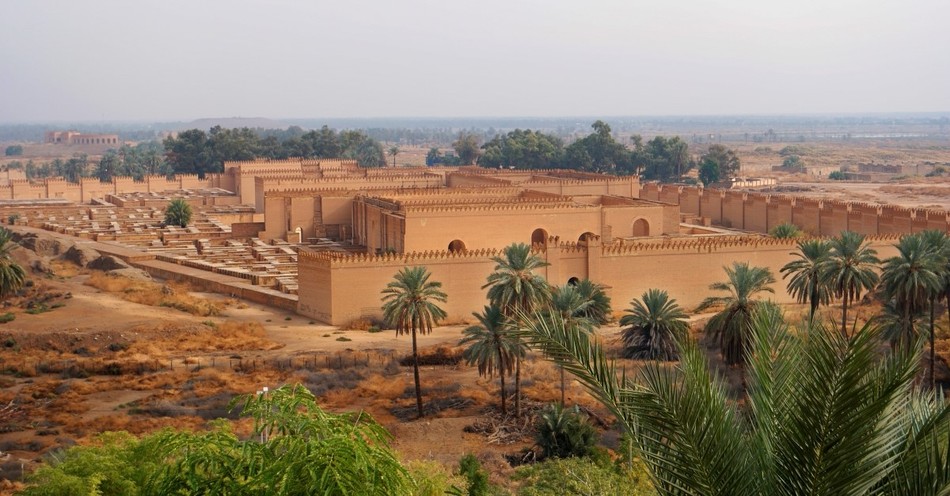Babylon was one of the most powerful and influential kingdoms in the ancient world. Located in what is now present-day Iraq, Babylon played a pivotal role in the history of Israel. Though it eventually fell to the Medo-Persian Empire, the emergence of a new Babylon is prophesied in the book of Revelation, a final global empire to fall before the heralded return of Jesus Christ.
The Origin of Babylon
The Babylonian Empire became a major world superpower in roughly the sixth century before Christ. However, its origins can be traced back to the Tower of Babel.
Following the Great Flood (Genesis 6-10), the Bible tells us that the descendants of Noah multiplied and migrated throughout the earth (Genesis 10:1-32).
Nimrod, a descendent of Noah’s son Shem, was said to be “a mighty hunter before the Lord” (Genesis 9:9). His people traveled east, eventually settling on a plain in the land of Shinar (Genesis 9:10). There, Nimrod’s descendants decided to build a tower “reaching to the heavens” to make a name for themselves (Genesis 11:2-4). They were unified in their efforts at this time as they still spoke the same language.
God, however, took notice of this special project, saying, “they are one people, and they all have the same language. And this is what they began to do, and now nothing which they purpose to do will be impossible to them” (Genesis 11:6).
Why was the tower a concern to God? A few explanations can be provided.
The issue was not God’s displeasure with the construction of large buildings—though some have wondered whether or not the builders thought building a skyscraper would safeguard against future floods, thereby avoiding God’s judgment. That’s entirely possible.
However, as John Dyer explains in From the Garden to the City, the key problem was building the tower was an act of self-glorification:
“rather than using their creative powers to honor God as Noah did, the people of Babel wanted to bring glory to themselves. Rather than live in dependence upon God (as Abraham will in the coming chapters), they tried to achieve complete autonomy from him. Like Cain, the people of Babel saw technology as the means by which they could overcome the limits of a sinful world and remain independent of God. When God created the garden, He put humankind in it to reflect His image. At Babel, we find humans creating a city as their anti-garden and a tower as an image to themselves.” (Dyer 104)
The issue, again, was not one of technology and innovation but rather morality. The people of Babel believed they could exceed God’s reach and disregard His command to multiply and fill the earth.
In response, God confused their language, making it impossible for the builders to understand and therefore communicate with each other. As a result, work on the tower ceased, and the people dispersed. The Lord had effectively “scattered them abroad from there over the face the earth,” as was His original design (Genesis 9:1; 11:8-9).
The Bible then tells us that this place became known as Babel, or balal, the Hebrew word for “confusion” (Genesis 11:9). It is the same root word from where we get Babylon, the mighty civilization born from the remnant at Babel.
Babylon, King Nebuchadnezzer and Israel
Throughout the Old Testament, various kingdoms and rival nations opposed the nation of Israel. None was more powerful or influential than the Babylonian Empire.
We know from history that Babylon was considered one of the ancient world’s greatest intellectual, cultural, and religious centers. Settled along the Euphrates River, in what is now Iraq, Babylon was known for its laws, religion, and architectural achievements—including the Hanging Gardens of Babylon, one of the Seven Wonders of the Ancient World.
Ironically, the same civilization responsible for such ingenuity and achievement bore the name of its ancestors at Babel: “confusion.” Furthermore, in the Bible, Babylon is often portrayed to symbolize sin, secularism, and hubris.
By the time Israel was divided into the northern kingdom (Israel) and the southern kingdom (Judah), the Assyrians, one of several kingdoms born of Nimrod’s line, had already become a major world power. Always the aggressor, the Assyrians invaded Israel in 722 BC, eventually destroying the northern kingdom later that year.
God, however, sent Nahum the prophet to warn the Assyrians that their evil deeds and violence against His people would not be forgotten (Nahum 1:9; 3:5-6).
Fulfilling God’s promise, the Babylonians rebelled against the Assyrians in 626 BC and overcame them as the dominant world power by 612 BC.
Unfortunately, the cautionary tale of Israel’s fall to the Assyrians was not enough to convince the people of Judah to repent of their idolatry. As a result, by 630 BC, the prophet Zephaniah warned that judgment would come to Judah if they didn’t forsake their idols and return to God with their whole hearts (Zephaniah 1:4-6).
As was often the case, however, the prophet’s words were disregarded (Zephaniah 3:2).
Therefore, the prophet Habakkuk delivered the sobering pronouncement that God would soon use Babylon as His rod of discipline to judge His people for their infidelity (Habakkuk 1:5-6; 1 Chronicles 9:1; Jeremiah 21:10).
In 605 BC, as prophesied by Isaiah and others, King Nebuchadnezzar of Babylon invaded the southern kingdom. He defeated its king Jehoiakim and took many Judean young men, Daniel among them, back to Babylon as captives (2 Kings 20:18; 24).
Nebuchadnezzar returned to Jerusalem in 597 BC, taking an additional 10,000 Israelites captive while removing many of the sacred vessels from Solomon’s temple (2 Kings 20:17; 2 Chronicles 36:7, 18); and in 586 BC, he finished the job, destroying Jerusalem and the temple entirely (2 Kings 25:11, 24; 1 Chronicles 9:1; 2 Chronicles 36:20; Jeremiah 20:4-5). Jerusalem's survivors were taken to Babylon, where they spent the next 70 years as exiles in captivity (Ezra 5:12).
The prophet Jeremiah writes of Jerusalem’s destruction in the book of Lamentations.
The Fall of the Kingdom of Babylon
In the book of Daniel, we read that King Nebuchadnezzar of Babylon was given a dream of a large statue with a head made of gold, breast and arms of silver, belly and thighs of bronze, legs of iron, and feet partly of iron and partly of clay (Daniel 2:31-33).
The Hebrew statesman Daniel interpreted that each section of the giant statue represented a kingdom that would eventually rise and replace the one before it.
The golden head represented Babylon. The chest and arms of silver represented the emerging Medo-Persian Empire. The belly and thighs of bronze would become Greece. And the legs of iron and feet of iron and clay symbolized Rome.
In 539 BC, not long after Daniel had interpreted the king’s dream, the Persian Empire under Cyrus II fulfilled its role in Nebuchadnezzar’s dream. That year the Persians conquered Babylon, deposing Belshazzar and placing Darius the Mede as the region’s governor (Daniel 5:30-31; Isaiah 13:17).
This fulfilled what God had promised through the prophets Jeremiah and Isaiah that Babylon would be punished for its cruelty towards God’s people in exile (Jeremiah 25:12; 50:18, Isaiah 13:19;).
Babylon the Great in Revelation
In the book of Revelation, the apostle John records a vision of the fall of Babylon the Great in the last days before Christ’s return (Revelation 14:8; Revelation 18:21).
Of course, those familiar with the Old Testament may read this and wonder: didn’t Babylon fall to the Persians in 539 BC? Why does Babylon again appear in end times prophecies?
Throughout history, the kingdoms of the earth, built by proud, sinful hands, have always believed they could live independently of God, ushering in their own man-made utopia apart from God.
However, no kingdom, not even Babylon, could ever compare to the majesty of Christ’s eternal kingdom described in Revelation. All nations and earthly kingdoms are a mere “drop in the bucket” to God (Isaiah 40:15). As Job concluded, “He makes the nations great, then destroys them; He enlarges the nations, then leads them away” (Job 12:23).
Many believe that the Babylon of Revelation, like the physical empire it is named after, represents a final world empire that ultimately seeks to rule in God’s place.
Whether the Babylon of the end times becomes the name of an actual city is unknown. Some believe that a literal city near the Euphrates will become the capital of a final Antichrist’s earthly kingdom. Others have linked the prophesied Babylon to Rome or Jerusalem.
In any case, the Babylon of Revelation will be the center of the Antichrist’s secular world empire; and its sole agenda will be to wage war against the Lamb of God and His people. Like ancient Babylon, the Babylon of end times will also be a godless, cruel, totalitarian society marked by rampant sensuality and pride.
However, Revelation tells us that, in one moment, like a millstone tossed into the sea, the great city will be brought to ruin and never rise again (Revelation 18:21). Like the Babylon of old, the Babylon of Revelation will fall, and the unredeemed will mourn her loss.
However, as Daniel had previously warned King Nebuchadnezzar: “the God of heaven will set up a kingdom which will never be destroyed, and that kingdom will not be left for another people; it will crush and put an end to all these kingdoms, but it will itself endure forever.” (Daniel 2:44)
Every kingdom and nation has a preordained time and place established by God, and God alone knows the day He will judge the world and its people in righteousness (Acts 17:31).
The Babylon of history played a role in God’s plan for Israel. The Babylon of the last days will also be instrumental in preparing the earth for Christ’s return. Its fall will be one of the final events to transpire before the second coming of the Lord Jesus Christ and the beginning of His great and glorious kingdom.
Babylon became a symbol of God's enemy due to its history of pride, idolatry, and oppression, particularly against the people of Israel. Known for its immense pride and the worship of false gods, Babylon’s legacy of defiance against God is illustrated early on in the story of the Tower of Babel, where people tried to build a tower to reach the heavens, symbolizing human arrogance and the desire to be like God. This prideful spirit continued throughout Babylon's history, culminating in its conquest of Jerusalem, the destruction of the Temple, and the exile of the Jewish people, events that marked a period of great suffering for the Israelites and highlighted Babylon's role as an oppressor.
Furthermore, Babylon came to represent the epitome of worldly power and corruption. In the Book of Revelation, it is depicted as a "great prostitute" and a center of immorality and sin, symbolizing any system or power that opposes God's authority and leads people away from Him. Through its embodiment of pride, idolatry, and oppression, Babylon became a powerful symbol of opposition to God's will and His people, standing as a cautionary example of the consequences of defying divine authority.
Photo Credit: Getty Images/Dion Lefeldt Rezaei

This article is part of our Bible resource for understanding the significance and meaning of biblical phrases and ideas. Here are our most popular Bible articles to grow in your knowledge of God's Word:
Promises of God in the Bible
Is "This Too Shall Pass" in the Bible?
What Was the Ark of the Covenant?
Top 10 Bible Stories for Kids
“Iron Sharpens Iron” in Proverbs 27:17
"Fearfully and Wonderfully Made" in Psalm 139
“Be Still and Know That I am God” in Psalm 46:10
"No Weapon Formed Against Me Shall Prosper" - Isaiah 54:17



